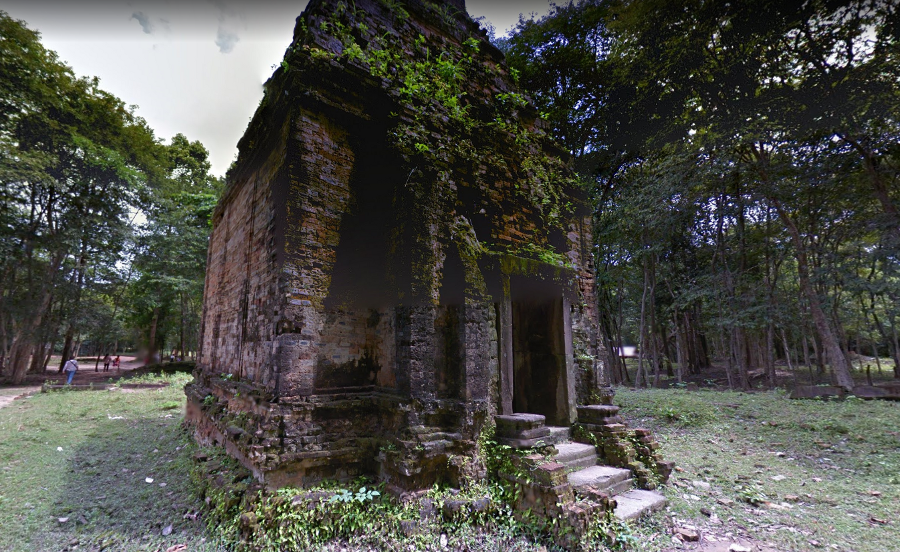“My darling, it’s been so long.”
She approached her lover near the steps of the temple. He was as she remembered him and she was also unchanged and unchanging across the vast expanse of time.
“Beloved, we are finally alone, alone to love and be loved.”
“They have not loved. Their world, the one we gave them…”
“I know, Shakti. That’s why we are here.”
“Yes, Shiva. To make the world we gave them, to remake it.”
The nude couple, parted for centuries, approached each other slowly.
They came together and embraced with passion. Shiva the Supreme Being and Shakti the goddess of female creativity made desperate love on the steps of Sambor Prei Kuk Temple in what is now known as Cambodia. When Shakti gave birth again, humanity would have the gift of a brand new world and hopefully, they will take better care of this one.
I wrote this for the What Pegman Saw writing challenge. The idea is to take the Google street map image above and use it as the inspiration for crafting a piece of flash fiction no more than 150 words long. My word count is 148.
Today, Pegman takes us to the Sambor Prei Kuk Temple in Cambodia. I Googled the location and Wikipedia told me all about the temple, Shiva, Shakti, and the meaning of the terms Lingam and Yoni. Since all that seems pretty sexy, I played fast and loose with mythology and decided to have a little fun as well as offer a bit of hope.
To read other stories based on the prompt, to go InLinkz.com.



Still waiting on that birth, I am afraid. Nicely told.
LikeLiked by 1 person
Thanks, JHC. Sadly, though I can write fiction, I can’t actually make it come to life.
LikeLiked by 1 person
We could use that brand new world any day now.
LikeLike
I agree. Shakti better get busy giving birth.
LikeLiked by 1 person
Shavua Tov — As I read your little riff on the Shiva-Shakti saga, I couldn’t help noticing a curious similarity to the myth of Baal and Astarte. I wonder what I might find with a bit of research into the approximate timing of when these myths originated. They both go back millennia — more than four in the case of Baal the Canaanite deity — yet they both must be post-diluvian (within the past 4500 years per biblical genealogy calculations). I wonder if, in fact, they have a common origin among the early generations of survivors after the Great Flood, when a very few survivors faced the daunting task of “creating a world” by producing as many children as possible. Hence we can envision justification for the strong sexual components as the symbol for creating a world. In this case, I think, the likely origin is among the Hamitic descendants of Noa’h.
LikeLike
I made up all the stuff about her giving birth to a new world, but not you’ve got me curious, PL. I’ll look into it when I have a moment.
LikeLike
Nice!!! Kisses ❤ ❤ ❤
LikeLiked by 1 person
Still waiting……
LikeLiked by 1 person
That’s a lovely imaginative take on the prompt. Nicely told, James
LikeLiked by 2 people
Dear James,
I’m not holding my breath waiting for them to give birth to a better world. If humans are involved we’ll just mess up the new one. 😉 Good story. Imaginative.
Shalom,
Rochelle
LikeLike
Thanks, Rochelle. I can dream, can’t I?
LikeLike
A brave newt creative world, James… brings to mind a recent quote from the Dalai Lama…
“The planet does not need more successful people. The planet desperately needs more peacemakers, healers, restorers, storytellers and lovers of all kinds.”
LikeLike
Thanks, Kelvin. I doubt most people, at least in western nations, would ever get that.
LikeLiked by 1 person
Shiva and Shakti gave birth to Ganesha and Kartikeya. But, guess the world has come to a state that we need another supreme being to set it all right.
Click Here to see what Mrs. Dash Says
LikeLike
Thanks for that. As I mentioned, I played rather fast and loose with mythology here.
LikeLike
I think the problem is that folks don’t relate properly to the supreme being we already have. As it was written in the Torah passage Deut.32:3-5 – “… I will proclaim the purpose of HaShem: ascribe greatness unto our God. The Rock, pure is His action: for all his ways are justice: a God of truth and without iniquity, he is just and upright. Corruption is not in Him, in his children is their own blemish: they are a perverse and crooked generation.”. In other word, there is nothing wrong with the Supreme Being Who created the heavens and the earth; and, not much longer now, He will be completing the job of setting it all aright again. The only delay has been in some manner an attempt to limit the casualties — as He does it — among those who would rather be their own supreme being and to do things their own way rather than the right way.
LikeLiked by 1 person
I just want to be clear that I’m writing about (from my point of view) mythological beings so this is plainly fictional. I have actually written Biblical fiction from time to time and yes, though the events aren’t factual, they are based on my theological perspective. In some ways, that makes for more difficult writing.
LikeLike